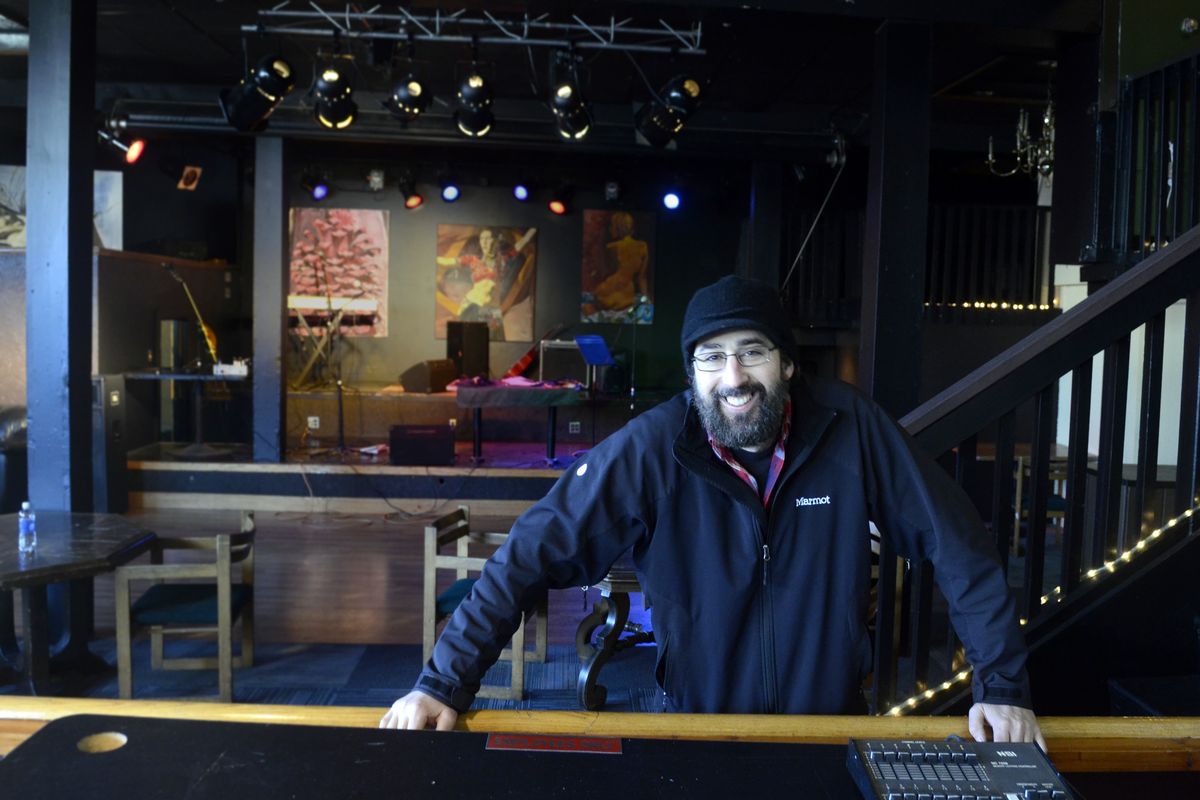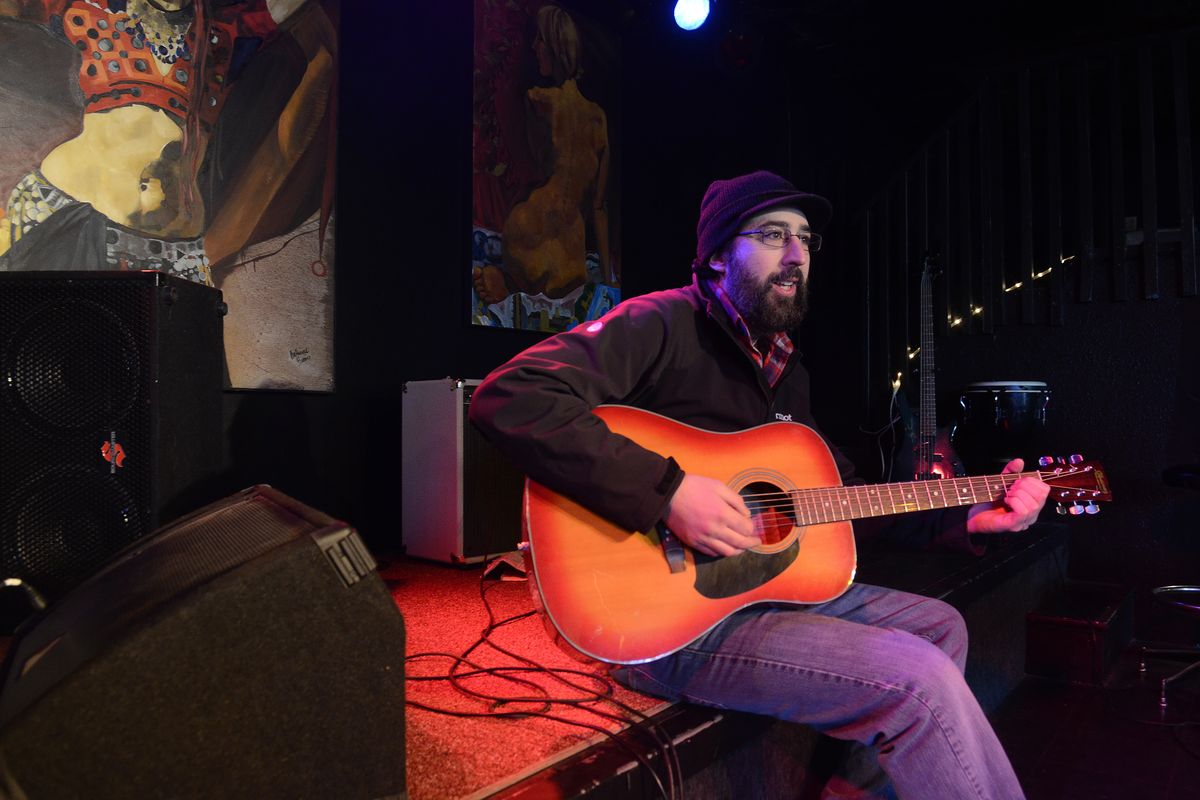Dan Hoerner hoping to fill Big Dipper again
Dan Hoerner stands near the stage at the Big Dipper club at Second Avenue and Washington Street. He wants to open the Big Dipper again but has to install a sprinkler system and is trying to raise the money via Indiegogo. (Jesse Tinsley)Buy a print of this photo
Dan Hoerner still remembers where he was when he knew he was going to become a musician. It was May 1988, at the long-defunct Spokane venue 123 Arts on South Madison Street, during a show headlined by iconic post-hardcore band Fugazi, and it was Hoerner’s 19th birthday.
“I stood a foot away from (lead singer) Ian MacKaye for the entire set, right in front, and I got to talk to him after,” Hoerner said. “That was my inspiration to become a musician. I wanted to play guitar like him. And that happened here in town.”
Hoerner, 44, went on to form the influential Seattle emo-rock group Sunny Day Real Estate, and now he’s reopening the Big Dipper, 171 S. Washington St., one of Spokane’s most venerable and longstanding venues. He hopes one day, 20 years from now, another musician will recall a similarly transcendent experience they had at his venue.
The building now known as the Big Dipper has been sitting on the corner of Washington Street and Second Avenue for a little more than 100 years, and it was first used as a full-time music venue in the late 1980s after a lengthy stint as a bar. It’s a hard place to miss: The brick exterior is painted bright blue, and one of the walls is adorned with a painting of an ethereal woman perched atop the Ursa Major constellation (Hoerner and his wife, Dawson, have dubbed her Ursa Nightingale). The Dipper has opened, closed and changed hands many times over the years, most recently housing the late Empyrean Coffee House, which closed in early 2011.
Hoerner envisions the Big Dipper as a thriving all-ages music venue, but don’t expect a rock band on his stage every night. “I’m too old and too eclectic, and I want more than that,” he said. “I want string quartets in here. I want big band and jazz. I want karaoke, cosplay, ‘Dr. Who’ night, comedy. This is not just your rock club or your punk club. I want to mix it up.”
He’ll also have a full kitchen and a pizza oven, and he’s developing a menu of high-end cocktails, craft beers and “upscale comfort food.”
Born and raised in Spokane, Hoerner left for Seattle after graduating from Mead High School, receiving a degree in psychology from the University of Washington two weeks before Sunny Day Real Estate signed a contract with Sub Pop Records in 1993. When the band quietly dissolved two years later (they’ve reunited for tours and albums several times since), bassist Nate Mendel and drummer William Goldsmith joined the first lineup of the Foo Fighters, lead singer Jeremy Enigk embarked on a solo career and Hoerner moved to a small farm just outside of Fruitland, Wash.
The Big Dipper was a big part of Hoerner’s formative musical years, and he recalls playing shows at the then-21-and-over club before he was legally allowed to watch a concert there. “I remember being freezing cold, waiting outside there,” he said, pointing to a red door to the right of the stage that leads out to the sidewalk, “then hearing, ‘OK, you’re on!’ I’d come in, go straight to the stage, play and then get right off.”
Hoerner moved back to Spokane with his wife and three kids a few years ago, and he began to hear rumblings that the Big Dipper had fallen into disrepair. “A friend of mine had been down here and had been invited inside, and what he saw inside was horrible,” Hoerner said.
When he finally saw the building for himself, Hoerner said it was worse than he’d imagined: There was rot, mold and considerable foundational damage, which gave the impression that the Dipper had been slapped with one fresh coat of paint after another without ever receiving the structural overhaul it desperately needed.
Knowing that it was only a matter of time before his adolescent paradise would be paved to put up a parking lot, Hoerner offered to buy the property from owner Steve Spickard; he’s currently under a lease-to-own agreement. “We started talking mights and maybes and kind of got excited about the challenges – I can do that, I can fix that,” Hoerner said. “So we started to take it on like kids playing Legos. We wanted to fix a broken building.”
For the past nine months, Hoerner and his business partner Troy Brower have been refurbishing the Big Dipper from the ground up: They’ve replaced the broken furnace, reinforced the leaky roof, salvaged some of the building’s 100-year-old wood and, naturally, applied a fresh coat of paint. The building itself presented a number of obstacles, but Hoerner couldn’t have anticipated that the city of Spokane would end up supplying both his biggest hurdle and his most valuable support.
The city inspectors limited the Big Dipper’s capacity to just 110 people, and if Hoerner wanted to increase that number, he’d need to install an updated – and expensive – sprinkler system. “With 110 people in this building, if you pack them all in front of the stage, the first 15 feet look crowded and the rest of the building looks empty,” Hoerner said. “110 people are not enough for this building to survive and thrive.”
In February, Hoerner launched a campaign on the crowd-funding website Indiegogo to raise money toward new sprinklers. Although Rolling Stone picked up the story and promoted the Indiegogo site, only 10 percent of Hoerner’s ultimate goal of $50,000 was contributed.
It appeared that the Big Dipper had hit a serious snag until earlier this week, when it was announced that the city would be connecting the water main under the street to the Dipper’s main water line. The city is fully funding the project, which will eventually slash the cost of the venue’s new sprinkler system, originally estimated between $25,000 and $30,000, nearly in half.
Hoerner said his goal is to have a fire suppression system in working order by summer, which should, based on the Dipper’s square footage and layout, increase the occupancy to close to 300 people. He credits Jan Quintrall, the city’s director of Business and Development Services, with getting the process moving forward.
“Jan is very pro-business,” he said. “It would be foolish to let the Big Dipper go away and become just another black hole. This is only going to make the building safer and more economically viable. The city is going to gain by having this done.”
The issue of outdated water lines is common in older buildings, and Quintrall said that it’s one most owners aren’t expecting.
“It’s not just the Big Dipper; it’s really a holistic thing as we look at all these buildings in the downtown core,” she said. “If we want to see reinvestment in these buildings, the least we can do is say, ‘We’ll cut into the street, we’ll run the water line and you won’t have to pay for that.’ It’s a very small thing, but sometimes that’s what it takes.”
Quintrall estimated the process will run from $12,000 to $18,000, which will be fully covered by the city’s street and water departments.
If the Big Dipper succeeds as Hoerner expects it will, it could jumpstart a local scene that has suffered a recent drought of live venues, especially those open to younger audiences. He said he’s encouraged by the recent success of the Bartlett, Spokane’s newest all-ages venue, because the music community can’t thrive without multiple venues in operation. (Hoerner said the Bartlett’s owners, Caleb and Karli Ingersoll, were among the first to contribute to his Indiegogo campaign.)
“The only way for the music-listening community to grow in Spokane is for there to be more places of contact with music,” Karli Ingersoll said. “It inspires more musicians to be active in the scene and more people to go out to shows. It’s generally good for the infrastructure of the music scene. Also, the Dipper is unique and has long time ties to music in Spokane.”
“When you have multiple, vibrant places that are all percolating on their own schedules, that’s when you know you can go downtown and have a good time,” Hoerner said. “That’s what we’re doing, and that doesn’t happen with just one club … (Culture) just doesn’t happen in a vacuum.”
Since Hoerner took over, the Big Dipper has already hosted a handful of small events – there was a benefit show for community radio station KYRS last month, and a Get Lit! program earlier in the week – and he’s planning a grand opening party next month.
Hoerner said he’s been surprised by the magnitude of support – from friends, musicians, fellow venue owners and city officials – his Big Dipper revitalization project has inspired.
“There are so many people who want to work for the Big Dipper and who want to volunteer,” Hoerner said, “Chefs, bartenders, sound guys, lighting guys. People I’ve never met before have come up to me and said, ‘Hey, I used to do this at the Big Dipper. Let me come down and I’ll show you how to do this and I’ll fix this.’ There is so much goodwill toward the Big Dipper, and that’s the other piece of our puzzle.”

